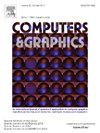GRPE: High-fidelity 3D Gaussian reconstruction for plant entities
IF 2.5
4区 计算机科学
Q2 COMPUTER SCIENCE, SOFTWARE ENGINEERING
引用次数: 0
Abstract
3D Plant models hold significant importance for constructing virtual worlds. Currently, there is a lack of algorithms capable of achieving high-fidelity reconstruction of plant surfaces.
We propose a unified architecture to reconstruct high-fidelity 3D surface models and render realistic plant views, which enhances geometric accuracy during Gaussian densification and mesh extraction from 2D images.
The algorithm initially employs large vision models for semantic segmentation to extract plant objects from 2D RGB images, generating sparse mappings and camera poses. Subsequently, these images and point clouds are processed to produce Gaussian ellipsoids and 3D textured models, with the algorithm detecting smooth regions during densification. To ensure precise alignment of the Gaussians with object surfaces, the algorithm incorporates a robust 3D Gaussian splatting method that includes an outlier removal algorithm. Compared to traditional techniques, this approach yields models that are more accurate and exhibit less noise. Experimental results demonstrate that our method outperforms existing plant modeling approaches, surpassing existing methods
In terms of PSNR, LPIPS, and SSIM metrics. The high-precision annotated plant dataset and system code are available at https://github.com/DYH200009/GRPE.

GRPE:植物实体的高保真三维高斯重建
三维植物模型对于构建虚拟世界具有重要意义。目前,缺乏能够实现植物表面高保真重建的算法。我们提出了一种统一的架构来重建高保真的3D表面模型并呈现逼真的植物视图,从而提高了高斯密度化和从2D图像中提取网格的几何精度。该算法最初采用大视觉模型进行语义分割,从2D RGB图像中提取植物对象,生成稀疏映射和相机姿态。随后,对这些图像和点云进行处理,生成高斯椭球和三维纹理模型,并在致密化过程中检测光滑区域。为了确保高斯与物体表面的精确对齐,该算法结合了一个鲁棒的3D高斯飞溅方法,其中包括一个异常值去除算法。与传统技术相比,这种方法产生的模型更准确,噪音更少。实验结果表明,我们的方法优于现有的植物建模方法,在PSNR, LPIPS和SSIM指标方面优于现有方法。高精度带注释的工厂数据集和系统代码可在https://github.com/DYH200009/GRPE上获得。
本文章由计算机程序翻译,如有差异,请以英文原文为准。
求助全文
约1分钟内获得全文
求助全文
来源期刊

Computers & Graphics-Uk
工程技术-计算机:软件工程
CiteScore
5.30
自引率
12.00%
发文量
173
审稿时长
38 days
期刊介绍:
Computers & Graphics is dedicated to disseminate information on research and applications of computer graphics (CG) techniques. The journal encourages articles on:
1. Research and applications of interactive computer graphics. We are particularly interested in novel interaction techniques and applications of CG to problem domains.
2. State-of-the-art papers on late-breaking, cutting-edge research on CG.
3. Information on innovative uses of graphics principles and technologies.
4. Tutorial papers on both teaching CG principles and innovative uses of CG in education.
 求助内容:
求助内容: 应助结果提醒方式:
应助结果提醒方式:


